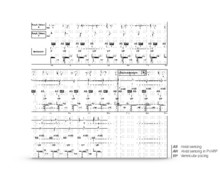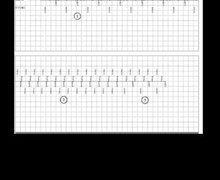Crosstalk and ventricular sensitivity
Tracing
Manufacturer Biotronik
Device PM
Field Refractory periods
N° 12
Patient
67-year-old man implanted with an Evia DR-T dual-chamber pacemaker for a syncopal paroxysmal atrioventricular block; programming in DDD mode; routine consultation and recording of the tracing.

Graph and trace
Tracing 12a
- AS-VS event properly sensed; AS-VS interval of 180 ms;
- T wave oversensing by the ventricular channel over 2 consecutive intervals;
Tracing 12b
- ventricular pacing with pseudo-fusion pattern (stimulus but no change in ventriculogram pattern);
- slowing of the sinus rate and unipolar atrial pacing; crosstalk with signal sensed by the ventricular channel and pacing at the end of the safety window with ventricular capture; T wave oversensing;
Tracing 12c
- change in chart speed for better visualization of the crosstalk; it is possible to visualize a signal of small amplitude on the ventricular channel following atrial capture; this signal is sensed after the post-atrial ventricular blanking, in the safety window and triggers ventricular pacing with capture 100 ms after the atrial pacing.
Other articles that may be of interest to you







The sensing of atrial activity does not trigger refractory periods in the ventricle, the risk of oversensing being relatively limited (spontaneous atrial signals of low amplitude). In contrast, following an atrial pacing, it is imperative to protect the ventricular chamber, the risk of crosstalk being high (pacing in Volts, sensing in mV with a ratio of 1 per 1000).
A programmable ventricular blanking period (between 30 and 70 ms with a nominal value of 30 ms) is therefore triggered after an atrial stimulus. This period is intended to avoid sensing of the atrial stimulus by the ventricular sensing chain which would result in ventricular inhibition. A ventricular signal occurring during post-atrial ventricular blanking is not sensed and therefore does not inhibit ventricular pacing occurring at the end of the programmed AV delay.
The safety window is a ventricular sensing period as an adjunct to post-atrial ventricular blanking. It is only initiated after atrial pacing and is designed to prevent ventricular asystole due to inappropriate inhibition of ventricular pacing by the sensing of atrial stimulus or depolarization. Ventricular sensing occurring after post-atrial ventricular blanking but before the end of the safety window is considered non-physiological and triggers ventricular pacing at the end of the safety window. The short AV delay feature allows the recognition of a safety window pacing on the electrocardiogram. If the event sensed in the safety window is the result of crosstalk or oversensed noise, the pacing pulse allows effective ventricular capture at the end of the safety window. If the event sensed in the safety window corresponds to a late PVC or to atrioventricular conduction, the pacing at the end of the safety window occurs sufficiently early during the absolute myocardial ventricular refractory period to avoid pacing at the peak of the T wave. The safety window extends up to 100 ms after the atrial pacing (immutable value).
In this asymptomatic patient, this crosstalk associated with T wave oversensing on both the spontaneous ventricular event and the paced ventricular event indicates that the device is too sensitive at the ventricular level. A reduction in sensitivy (increase in the programmed value) allowed resolving both problems.